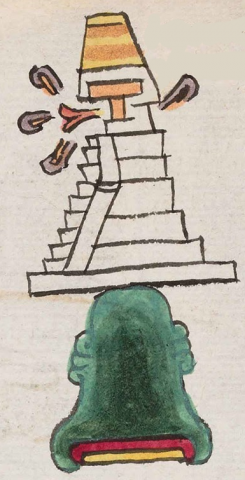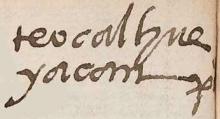Teocalhueiacan (Mdz5v)
This compound glyph for the place name Teocalhueiacan has two principal components. One is a temple of the type called teocalli. It is a pyramidal construction with many steps and a calli (house, building) at the top. The calli has a T-shaped wooden beam entrance and a thatched roof. The temple and the house above it are both shown in profile, facing left. One red, bifurcated flame and four curls of purple-orange smoke emerge from the lower part of the calli atop the pyramid, suggesting it is a town that has been defeated (what we would call tepehualiztli). The locative suffix (-can, where) is not shown visually. Below the teocalli is a classic tepetl (hill, mountain), with its two-tone green bell shape, rocky outcroppings on its slopes, and horizontal yellow and red lines at its base. The tepetl can serve as a silent locative in place of the -can locative suffix, which is not shown visually.
Stephanie Wood
The placement of the calli on top of a temple with the steps clearly on the left side, suggests that both are shown in profile, facing left. In this collection of glyphs, we are suggesting that the calli glyph is typically shown in profile. We do not concur with Joaquín Galarza, who suggests that the calli glyph is simply half of a building in a frontal view.
Why the temple is burning, bearing the characteristics of the noun tepehualiztli, is unclear. It may be a pueblo that was attacked and brought under imperial hegemony. For other examples of glyphs and iconography relating to teocalli temples, see below. The tepetl does not have a phonetic role here, but may indicate an elevated geographic location for this temple. It could also be a glyph for altepetl or pueblo. The place name has, imbedded in it, the word hueiatl, which refers to a large body of water, such as a sea or a large lake or river. The body of water is not shown visually, but this temple would appear to have been located on a body of water.
Stephanie Wood
teocalhueyacan. puo
Teocalhueiacan, pueblo
Stephanie Wood
c. 1541, or by 1553 at the latest
Stephanie Wood
temples, templos, mares, lagos, ríos, defeat, conquista, derrota de un pueblo, fuego, humo, cerros, montañas, nombres de lugares

teocal(li), a temple, https://nahuatl.wired-humanities.org/content/teocalli
hueia(tl), a large body of water, https://nahuatl.wired-humanities.org/content/hueiatl
huei, large, https://nahuatl.wired-humanities.org/content/huei
a(tl), water, https://nahuatl.wired-humanities.org/content/atl
tepe(tl), hill, mountain, https://nahuatl.wired-humanities.org/content/tepetl
-can (locative suffix, where, https://nahuatl.wired-humanities.org/content/can-2
Codex Mendoza, folio 5 verso, https://digital.bodleian.ox.ac.uk/objects/2fea788e-2aa2-4f08-b6d9-648c00..., image 21 of 188.
The Bodleian Libraries, University of Oxford, hold the original manuscript, the MS. Arch. Selden. A. 1. This image is published here under the UK Creative Commons, “Attribution-NonCommercial-ShareAlike 3.0 License” (CC-BY-NC-SA 3.0).





